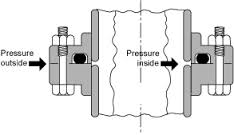Static Seal:
A seal that is made between two stable and immovable components
Dynamic Seal:
A seal required to prevent leakage past parts which are in relative motion
Types of Seals
 Static Seal: O-Rings, Back-up Rings, Square Rings, V-Rings, Dual Seals…
Static Seal: O-Rings, Back-up Rings, Square Rings, V-Rings, Dual Seals…
Dynamic Seal : Hydraulic and Pneumatic seals, Oil and Grease seals, Wipers and Scrapers, Labyrinth seals and more…
Manufacturers, of course re-name their products in order to enhance sales but essentially the above constitute the common names for the seals.
 How does a Static Seal Work?
How does a Static Seal Work?
A static seal is located in a groove and sees no movement – only sealing within its confined space, acting like a gasket between the mating surfaces. . Examples include seals for flanges, plugs, and tubing. As pressure increases, it deforms and reshapes the seal so that sealing pressure increases to withstand the greater containment requirements. O-rings, V-rings, and other shapes are typical examples.
View our Hydraulic Seals Introduction
 How does a Dynamic Seal Work?
How does a Dynamic Seal Work?
A Dynamic seal retains or separates fluids, also keeps out contaminants, and contains pressure. It creates a barrier between moving and stationary surfaces.
Dynamic seals are either contact or clearance. Contact seals bear against the mating surface under positive pressure. Clearance seals operate with positive clearance, therefore no rubbing contact.
Most dynamic seals are contact seals. The relative movement of the dynamic sealing system is rotary or reciprocating, separated by a thin layer of oil film, which also serves as a lubricant
A rod seal (also called internal seal) is exposed to movement on its inner diameter along the shaft or rod of a hydraulic cylinder. A piston seal also called external seal) is exposed to movement on its outer diameter along the tube or bore of a hydraulic cylinder.
Note: For the best sealing, the seal lip on a dynamic seal needs to point towards the medium being contained.



